Editorial
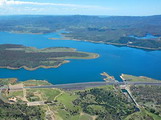
Are you wondering where the year went to, too? Must be an Old Guy thing. I don't think that time passed so fast when I was young, but I can't actually remember... Anyway, it's November (welcome to it) and I need to start thinking hard about next month's Members' Free Plan. It was real wet around here this month and all our reservoirs are officially full to overflowing. Naturally, water restrictions remain in place because the government realizes that they and their predecessors have all diligently neglected to track capacity against population growth, so they've fallen back on the one thing they are actually good at: legislation. Honestly, we are doomed and while it's easy to say at least I won't be around to see it, occasionally a withered streak of social conscience breaks through and makes me wonder how the situation can be fixed for future generations?

A previous administration actually tried to build another dam. Everyone thought this was a Good Idea™, but at the same time, "everyone" screamed loudly, ...but not in my backyard! Seems to me that political parties see the game as gaining and retaining power. Anything done for the "people" is coincidental, and primarily aimed at not losing power, so no dam. China on the other hand has no difficulty commanding constructions like the Three Gorges Dam. Of course this foresight comes at a cost in what we call human rights. Damned if I know what the answer is. Like Winston Churchill said, democracy is the worst form of government, except all the others that have been tried.
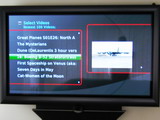
And what does this have to do with model engines? Not a thing, but I feel better. This month I've been spending most of my free time writing code for generation 3 of my Home Video on Demand project. I chose Perl as the implementation language so the same codebase would provide a GUI application that could be delivered to run under all flavors of MS Windows, Linux, Mac OSX, and even a few others not worth mentioning. This has worked out surprisingly well and my knowledge of Perl has risen exponentially. Now if only I had the time to watch all that video which I can now demand. Oh well. Down to tin-tacks...
Vale: Ron Moulton

One of the notable few who dedicated their lives to promoting model making and helping budding modelers of all types, including kites, passed away on November 8th. This was Ron Moulton, one time editor of the British magazines Aeromodeller and Radio Control Models and Electronics (RCM&E). Ron was the author of many books including The Control Line Manual, The Model Engine Encyclopedia, Flying Scale Models, Kites: A Practical Handbook, The Model Aircraft Handbook, and for many years, was the driving force behind those wonderful, treasured Aeromodeller Annuals which appeared each year between 1947 and 1979 (Ron compiled and edited the Annual from 1963 to the finish and that's him in the dark blue shirt assisting with the winding of C Rupert Moore's restored Viper at Old Warden, circa 2003). Ron also designed some delightful models and wrote construction articles on them that just made you want to start cutting balsa—how many of us in the old "Commonwealth" countries made a Rascal? I've made more than one.
It was my pleasure to exchange emails with Ron regarding engines, aeromodelling and aeromodelling people. For the past several years, Ron has been in the role of full-time carer for his wife, Betty, who also passed away recently. David Owen had dinner with him while in the UK a few weeks ago and commented to me that he was looking very frail (must remember never to ask Dave how I'm looking). I asked David to provide a few words and reminiscences of Ron which you can read on the Ron Moulton Tribute page.
So vale, Ron. Your influence will live on for a long, long time.
Peter Chinn's Collection for Auction
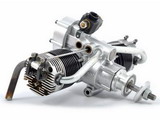
Ever wonder what happened to all the engines in Peter Chinn's collection? Wonder no more. They, together with some items from the late Dave Boddington and Brian Perks will go under the hammer at the Gildings Auction House on November 6th next. This is the twelfth annual model engine auction that Guildings has held and this year, visitors will have 670 lots to fight over. I have to thank Dick Roberts for this timely notice and his other kind words. To Dick as fallen the baton once carried by Dave Boddington and Ron Moulton as catalogue master for model engines (Ron had the difficult task of listing the collections of Miguel deRancougne, and OFW "Peter" Fisher). I know many readers will remember Peter Chinn's engine reviews best for the excellent photography of disassembled engines which enhanced them so effectively. Well surprise! A number of these never actually got assembled again, so some of the lots are NIBIP (New In Box, In Pieces). Luckily for bidders, Dick has noted which lots are in this state in the on-line catalogue listing. Bidding will be by commission, telephone, or personal attendance. Online bidding is not being offered due to cost.
QSMEE Oops
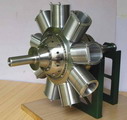
Last month, we posted a notice regarding the forthcoming Queensland Society of Model and Experimental Engineers which I had produced by blindly following the printed flyer given to me for the date for this event. So I was rather surprised when local BR2 builder, Neville Robertson, emailed to tell me I would have people turning up in the middle of the week! The date on the MEN website was quickly fixed, but just in case you are confused, it is scheduled for Sunday 14th of November, 2010. Sadly a lot of flyers with the temporal displacement of the Sunday in question went out, so tell your friends. The photo here shows Neville's progress on the BR2, which will be on display on the day. The engine is 1/3 scale from Neville's own plans. The bore and stroke are 43mm and 60mm respectively for a displacement of 784cc. The expected finished weight will be around 12-14 kg, hence the name "Big Beast". It's really great to see workmanship and dedication like this.
Coat of Paint at Hemingway
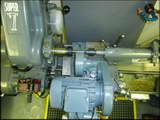
Kirk Burwell at Hemingway Kits emailed to let us know that the company web site has, in his own words, had a coat of paint, which is still wet. I've always thought the Hemingway site was rather nice—clean, uncluttered, and good navigation. Well now it's better and worth a browse where you'll find new things like the Dynamic Tool Post Grinder designed by Gordon Cornell. This design appeared long ago in Model Engineers' Workshop and is not something you can knock up without castings. These have been unavailable for a long time, so it's terrific that Hemingway have given the tool a second life. Also available is a 2-axis dresser for the tool post grinder and if you don't know what that is, or why you'd need one, you better visit the site. Last but by no means least, Kirk mentioned that progress is being made on bringing back several of the casting sets once offered by the late Roger Schroeder. Expect to see these become available in the new year—which is distressingly near and approaching way too fast!
Mmmm... Wooden Case...
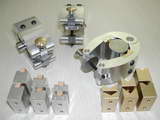
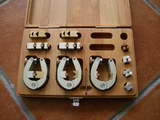
As well as a weakness for twins, any kind of tooling in a fitted wooden case will grab me every time. The external hones seen here are the work, or should I say craftsmanship of Tom Blough. Tom saw my feeble example of the hone on this web site and wondered how he might get the castings or drawings for one. That was a mere year ago and now Tom has a set which will cover any diameter a model IC builder is ever likely to encounter. They are almost too nice to use! With this out of the way, Tom plans to get back to his Hodgson radial project. Most just cut metal, but not Tom. He's modelled the entire engine in 3D CAD and has worked out some interesting ways to apply the same craftsmanship evident in the hones to the Hodgson. For example, have a look at the way he has matched the interior of the front cover to the curvature of the exterior. No-one except him is ever likely to see it, but that's what craftsmen do.
Stuff

Just look at that pipework! If you've never tried it, you probably have no idea how boring, tedious, and agonizingly tense the forming job is—all at the same time! By the sort of strange coincidence that is all too common around here, pipe forming for radial engines also gets a mention in this month's book review. The 18 cylinder radial is the work of Lars Milden (Sweden) and you can read more about it in the Gallery. We also have a new Watzit for you to identify. We can't, though we think we should! Incidentally, last month's Watzit will get the full treatment in the near future. The full story behind them was written up by our David Owen and appeared in Merv Buckmaster's Aeromodelling Digest for 1997. Dave has spoken with Merv who is happy for us to update and rework the story for these pages. Stay tuned...
Changes at SMR
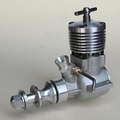
Steve Rothwell's SMR Precision web site has had a rework to place more emphesis on his engine work. Just in case you don't know, Steve makes Oliver inspired competition diesels that are just superb in every respect (as you should be able to tell from the photo of his R250 seen here, developed for use in Vintage A class Team Racing, Vintage Combat and Vintage Free Flight Power. Steve started flying control line in 1962 at KMFC and has been flying models ever since, competing in Combat, Racing and Free Flight. The new web site has details on his engines, tips for Team Racing, and photos of his machine shop equipment. Well worth a visit!
New Books and Magazines This Month

Issue number 22 of Model Engine Builder arrived in early October. This issue has 44 pages (including the covers) in the magazine itself, plus another five double-sided, double-size pages of drawings As always, the content spans a broad spectrum from how to bend stainless steel for the inlet and exhaust pipes of a Kinner radial (the design appeared in SIC and back issues are still available), to how to make a simple Stirling engine, with lots more in between. This issue has the second part on master cam design by Carl Wilson. Carl is working up to a complete cam grinder for model engines, explaining everything along the way. The issue also continues editor Mike Rehmus' adventures building my Humbug on tabletop Sherline equipment. The series is very well illustrated and Mike is passing on tips for beginners which he has discovered during the exercise. MEB is published five times per year and if you don't subscribe, you really should!
Engine Of The Month: DC Bantam

Ok, quickly there all you engine spotters, which is the Bantam and which is the Wasp? If you don't know, are not sure, or even don't particularly give a toss, check out Adrian Duncan's DC Bantam page which will describe how the engine came to be, it's good aspects (both of them), and it's less than good aspects. The Bantam dates back to 1959 and represents a lost opportunity, being a rushed design intended to make the manufacturer money rather than make the owners happy. Adrian also shows that the genesis of the Bantam lies in a much more successful DC product. Intrigued? Follow the links to find out what it is...
Tech Tip of the Month
This month's Tech Tip has nothing to do with the accompanying photo, so maybe I better explain it first. To me, producing your own castings represents one of the biggest challenges a model engineer with no prior experience in this area can face. My hat is off to those who have conquered the problems of melting aluminum, de-gassing the melt, gauging the right temperature for the pour, etc, etc. Making simple patterns for sand casting is not hard, though there is still a lot to learn in regard to "ramming-up", pattern extraction, etc. To go to the next level, try your hand at die casting, and that (finally) is what we are looking at here; a fine example of a simple die made by Rob Jenkins (Australia).
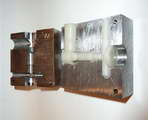
Rob's subject is the little Majesco Mite diesel using Motor Boy plans. This is a small engine, so there is no need to introduce plugs to core the casting. But notice how Rob has cunningly incorporated the venturi/tank-top as part of the crankcase so both can be done in a single pour. The wax used to prove the die is plain old candle wax. The die itself is ordinary steel of no particular parentage. From this Rob could produce waxes for investment casting, or, with some sort of riser arrangement added, pour molten aluminum direct into the release agent coated die. More as Rob's project proceeds.

Our actual Tech Tip this month provides Yet Another Way of holding your garden variety, overhung crankshaft while turning the crankpin. It comes from Jim Frew (UK) who also provided the pictures. As we already have what I thought was a comprehensive How-to page on the subject of crankshafts, I've added Jim's method at what seemed like an appropriate place, although placing it in the hierarchy of shaft holding methods was not as easy as it first looked because while the method is simple, precision is required in the making of the universal, re-usable jig(s). Curious? Click the prior link to review the Crankshafts Page, or this one to go direct to Jim's 4-jaw chuck method.
Bar Stock Bee

At first glance, it's just a Mk I ED Bee that someone has taken to with a can of Brasso and so much vigor that the embossing on the front of the crankcase has been worn away. This is not so; you are looking at a 1:1 scale model made entirely from barstock by Jim Frew (Dorset, UK). In a way, we have Motor Boy Bert Streigler to thank for the tank as it was made from a screwdriver handle—a process Bert pioneered which was our December 2003 Tech Tip. For more details of Jim's Bee, see The Gallery. I thought it was so nice that it made a fitting shot to end this month with. See you all in December...
 Vale: Ron Moulton
Vale: Ron Moulton
 Peter Chinn's Collection for Auction
Peter Chinn's Collection for Auction
 QSMEE Oops
QSMEE Oops
 Coat of Paint at Hemingway
Coat of Paint at Hemingway
 Mmmm... Wooden Case...
Mmmm... Wooden Case...
 Stuff
Stuff
 Changes at SMR
Changes at SMR
 Bar Stock Bee
Bar Stock Bee
 Editorial
Editorial
 New Books and Magazines This Month
New Books and Magazines This Month
 Engine Of The Month: DC Bantam
Engine Of The Month: DC Bantam
 Tech Tip of the Month
Tech Tip of the Month
 Standard Stuff
Standard Stuff
















